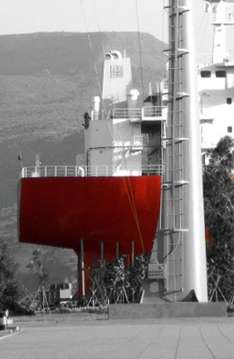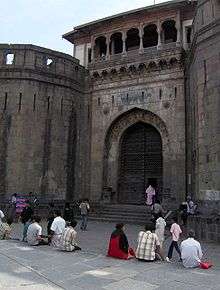Samundra Institute of Maritime Studies
 | |
| Type | Private |
|---|---|
| Established | 1 August 2005 |
| Principal | Mr. S.Viswanathan |
Academic staff | 70+ |
| Undergraduates | 200+ |
| Postgraduates | 150+ |
| Location |
Lonavala, India Mumbai, India 18°45′53″N 73°30′20″E / 18.764847°N 73.505573°ECoordinates: 18°45′53″N 73°30′20″E / 18.764847°N 73.505573°E |
| Campus |
|
| Colours | White |
| Sports | Cricket, Football, Tennis, Swimming, Basketball, Volleyball, Table Tennis, Boating |
| Nickname | SIMS |
| Affiliations |
Indian Maritime University, Directorate General of Shipping, Executive Ship Private Limited. |
| Website | http://www.samundra.com |
|
| |
The Samundra Institute of Maritime Studies (Hindi: समुन्द्र इंस्टिट्यूट ऑफ़ मेरीटाइम स्टडिज़) is one of India's advanced centres of marine engineering (marine propulsion) and navigation.
In addition to research, the institution offers extensive education and training in pre-sea and post-sea training for candidates ranging from cadets, on up through masters of great ships. The institute is recognised by the D.G Shipping, Government of India and affiliated to Indian Maritime University. The institute is sponsored by the Executive Ship Management Private Limited, Singapore. Spread over fifty acres (28 hectares) of land along the Indrayani River, on National Highway No.4 near Pune, India, the institute includes residential facilities for 400 candidates, an auditorium, a catering centre, an administration building, a "ship-in-campus", a Maritime science centre and a nautical & engineering workshop and swimming pool. The Institute boasts of LPG Simulator, one of its kind in the world, with hardware and software integrated together. Samundra Institute of Maritime Studies is the only Maritme Training Institute in India to have a free fall life boat training facility.[1]
Overview
The institute has been operational since 1 August 2005 with its pioneer batch comprising 40 deck cadets selected on merit and the first batch of Graduate Marine Engineering Scheme training started from October 2005. The curriculum for the cadet training, provides the candidate with the essential theoretical and practical training so as to prepare them to endure and excel in the life faced at sea.
The institute is a backward integration of Executive Ship Management Private Limited ( ESM), a ship management company based in Singapore.
Having instituted a Post Sea Training Facility, SIMS embarked on another training project in starting a Pre Sea Training Facility for deck and engine cadets. Located at Lonavala, Maharashtra, this campus complements the present post sea training offered in Govandi, Mumbai.
The institute was assessed in a comprehensive inspection program by the DG Shipping Govt of India in year 2015 and ranked No 1 among all maritime training institutes in India. The criteria for assessment included Infrastructure, ambience, faculty and quality of training imparted, student development program, onboard training and placement records.
Sustainable energy
The campus is notable for its employment of solar photovoltaic panels, one on a ninety-meter (293') long solar wall, is the longest in the world. Water is heated through the employment of solar heating panels. The campus plan is devised to re-generate the subterranean aquifer system. A water collection pool, near the river, acts as a holding pool, recharging and sustaining the micro-environment and bio-diversity of the campus. A system of canals and water management devices, temper the flow and retention of water in this drought prone area.[2]
Contemporary architecture
The campus has been designed by the award winning architect Christopher Charles Benninger[3] who has also designed the Mahindra United World College of India, the Center for Development Studies and Activities and the new campus for the Indian Institute of Management at Calcutta. The buildings have set a new trend in Indian modern architecture.[4] The Samundra Institute of Maritime Studies (SIMS) near Mumbai was established by Executive Ship Management (ESM) Singapore, to fulfill its new vision of an industry driven by environmental protection, safety and efficiency. Realizing that it must drive this mission through human resources it embarked on the creation of a sophisticated, state of the art, world class green campus where the full range of pre-sea and post-sea studies can be imparted.
Like ships floating upon a vast undulating sea, the sculpturesque buildings appear to float on the grass lawns. Steel and glass were employed to give the cadets a taste of sea life where existence is in a machine called a ship!
At the campus, which was completed in 2007, housing 400 cadets, energy efficiency begins to walk the talk with the campus producing 90 KW of energy through its photovoltaic panels, which lend unique character to facades whose appearance is driven by efficiency and not fashions! Photovoltaic cells, both translucent and opaque, became modern-day Indian ‘jaalis,’ allowing in natural light while blocking heat via the three hundred feet long photovoltaic solar wall in the Maritime Workshop; Asia’s longest, it produces 90 KW daily! Operable glass on the north façade brings in natural light, giving the testing equipment and machinery all-round illumination and ventilation. The Administration Building cleverly exploits northern light through its wavy glass atrium wall, while generating electricity through the grand photovoltaic south-facing façade that produces 30 KW. The structure is made of two walls, like a ship, that fall apart in the middle and then rejoin back in the end.
The long Students Hostel structure, which is a Two hundred and fifty meters long, glides over the grass ocean, like a catamaran in full wind! 400 cadets and post-sea officers are accommodated within five "ships" anchored at either end by the Auditorium (South) and the Catering Center (north). Aluminum louvers keep the bright sun off of the fenestration and the three Dining Halls are glass prisms facing north, with protective cladded concrete walls to the South and West. The interiors are cast-in-place concrete murals. This long ship floats above the Infinite Corridor, which acts as a covered walkway. Vertical stair silos moor this lofty structure to the site, like ship moorings in a port. The Academic Building is a composition of fourteen large classrooms, with cladded walls to the south and louvered glass. The large lineal atrium connects them all into one composition, with pointed, ship-like porches at either end.
All buildings have natural illumination, cutting consumption of non-renewable energy. Solar panels provide the entire heated water requirement, using circular hot water tanks held above the circular stairs. These seemingly frivolous shapes are integrated within a functional system of water management. The 82 feet tall central tank is vertically divided into four stages, with the raw bore well water progressively purified as it reaches the topmost tank, from where it is gravity distributed to the entire campus. Aluminum louvers in the Hostel and curved Academic Building allow natural ventilation and day light, while blocking India’s fierce sun, acting as a passive air conditioning system.
Two bio-sewerage treatment plants recycle grey water to gardens and water sinks. Compost banks produce organic fertilizer. Innovative water management makes the campus "water self-sufficient"! Eighty-percent of its water is re-cycled. Ground and rain water is harvested via catchment canals circling the campus, which is then stored within the two acre pond, which is the home of the "Ship-in-Campus;" an eight storied slice of a real ship allowing actual, instead of virtual, training. The Ship includes a desalination plant, sewerage treatment plant, generators, full scale engine, air-conditioning plants and fire safety systems, as well as tanker pumps. Fire prevention, life-boat operations and under-water sea operations are taught here.
Put in the words of Tata BP Solar CEO, "SIMS is a unique project and an engineering marvel, becoming the take home lesson for young cadets stepping into the world of sailing, who will determine the quality and the culture of the maritime industry in future years". This post-modern ensemble of statuesque objects, floating on a green sea carpet, are held into a visual pattern by the landmark water tower, axial pathways, River Indryani, NH-4, and the directional movement of the objects in space.
Accreditation
- ICRA Top Grade.[5]
- Recognized by the Directorate General of Shipping, India.[6]
- Indian Maritime University
- Maritime and Port Authority of Singapore.
- Det Norske Veritas, Norway for ISO 9001:2000.
- Maritime and Coastguard Agency (UK), Panama, Liberia and Marshall Islands Authorities (Ship Security Officers Course).
- Executive Ship Management Private Limited, Singapore. (Owner of SIMS)
- BP Shipping (Partner)[7]
Training facilities
The institute is spread out over a floor area in excess of 20,000 sq feet, SIMS provides hands-on training on simulators and various equipment as well as a training courses to ESM’s officers and ratings. The simulators include the only 240° field of view bridge simulator presently in India, an engine room simulator and a liquid cargo handling simulator – all loaded with programme modules based on present vessels under ESM’s management.[8]
- Some of the key facilities include:
- Simulators
- 240° Field of View Full Mission Bridge Simulator.
- Engine Room Full Mission Simulator.
- Liquid Cargo Handling Simulator (LCHS) for oil, gas and chemical cargoes.
- Electronic Chart Display Information System (ECDIS) simulator.
- Inert Gas Plant.

- Equipment
- Fully fitted-out Cargo Tank Replica with Framo pump.
- Automation Control Engineering Laboratory
- Hydraulic Trainer Equipment.
- Pneumatic Trainer Equipment.
- Miura Boiler Combustion equipment and controls.
- Terasaki Group Starter Panel.
- Main Engine Manoeuvring System.
- Other Fittings
- Basic electronic trainers
- Tanker fittings such as PV valves, tank cleaning machine
- Safety equipment such as BA sets, fireman's suit, BA compressor etc.
- Other Facilities
- Conference Hall
- Library
- Auditorium
- Briefing room
- Classrooms
- Student hostel with rooms
- Catering center
- Swimming pool, sports and recreational facilities
Awards
Samundra Institute of Maritime Studies has won the following awards for its architecture:[9]
- J.K. Cement-Architect of the Year Awards 2009, Best Educational Institute Award
- Indian Institute Architects Award 2008, Excellence in Architecture for Best Public Building
- Institute of Steel Development & Growth (INSDAG) 2009, Runner’s up for Best Steel Structure in India
- ArchiDesign Awards 2009, Architect of the Year Award
- World Architecture Festival Award 2009, Barcelona, Category: Education – Finalist
Pre sea courses at SIMS Lonavla
| SN | Course Name | Duration |
|---|---|---|
| 01. | DNS leading to BSc. Nautical Science (Deck Officer Training) | 1 year |
| 02. | GME (Engine Officer Training) | 1 year |
| 03. | B.Tech Marine Engineering (Engine Officer Training) | 4 years |
Post sea mandatory courses at SIMS Mumbai / Chandigarh / Cochin
| SN | Course Name | Duration |
|---|---|---|
| 01. | Chemical Tanker Familiarisation | 5 days |
| 02. | Specialised Training Program on Chemical Tanker Operations | 12 days |
| 03. | Oil Tanker Familiarisation | 5 days |
| 04. | Specialised Training Program on Oil Tanker Operations | 2 weeks |
| 05. | Liquefied Gas Tanker Familiarisation | 5 days |
| 06. | Specialised Training Program on Gas Tanker Operations | 2 weeks |
| 07. | Liquid Cargo Handling Simulator – Management Level | 5 days |
| 08. | Liquid Cargo Handling Simulator – Operational Level | 3 days |
| 09. | Engine Simulator - Management Level | 5 days |
| 10. | Engine Simulator - Operational Level | 3 days |
| 11. | Ship Manoeuvring Simulator | 5 days |
References
- ↑ "SIMS - Free Fall Life Boat". Samundra Institute of Maritime Studies. Retrieved 2 August 2011.
- ↑ "SIMS - World Architecture Festival 2009". www.worldbuildingsdirectory.com. Retrieved 2 August 2011.
- ↑ "SIMS - Christopher Charles Benninger Architects". www.ccba.in. 3 August 2011.
- ↑ "World Architecture Community:Samundra Institute of Maritime Studies, Lonavla, Pune". www.worldarchitecture.org. Retrieved 2011-01-11.
- ↑ "SIMS - ICRA Top Grade" (PDF). ICRA. 21 September 2010.
- ↑ "SIMS - DG Shipping Approval". DG Shipping. Retrieved 2 August 2011.
- ↑ "Chief Executive BP Shipping visits SIMS". Samundra Institute. 23 March 2007.
- ↑ "Training Facilities at SIMS". Samundra Institute. Retrieved 3 August 2011.
- ↑ "SIMS - Awads". www.e-architect.co.uk. Retrieved 2 August 2011.
